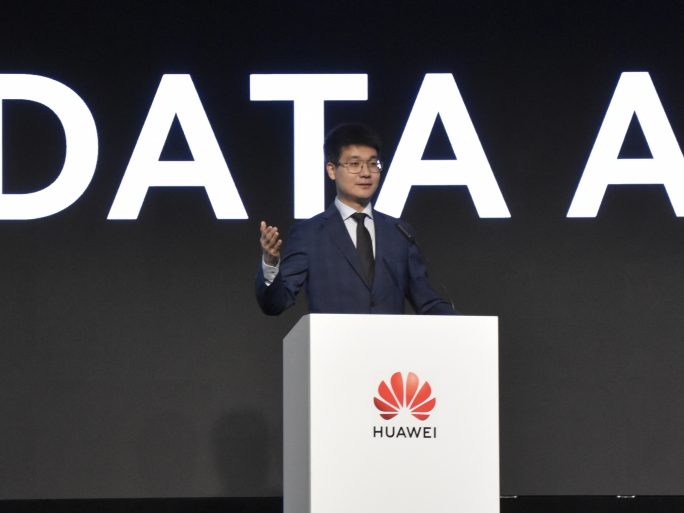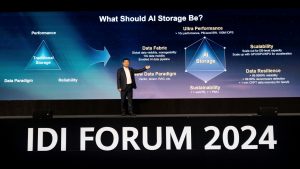Huawei Gears Up for the AI Revolution in Storage

During the Huawei IDI Forum 2024, the manufacturer showcases the potential of its line of storage solutions to respond to the boom in data and the adoption of artificial intelligence.
This week we attended the Huawei Innovative Data Infrastructure Forum 2024 in Berlin, the manufacturer’s meeting point to present the latest developments and trends in storage.
We are at an inflection point where the data handled by organisations continues to grow exponentially, but at a time when it is necessary to inject more doses of artificial intelligence to extract its full potential. Willi Song, president of Huawei Enterprise in Europe (in the cover image), stated at the opening of the conference that “AI will open up new opportunities over the next decade, but this will require the right infrastructure to cope with the use of these technologies”.
In a short time, we have moved from the era of data to the era of intelligence. It is a change that, like everything else in technology, is moving at a frenetic pace, so organisations must be prepared for it and not die trying, thus ensuring business continuity.
“In the fourth industrial revolution, data is experiencing explosive growth, placing greater demands on data infrastructure. How to build an AI-ready data infrastructure has become a common concern across the industry. However, every challenge we face is an opportunity,” he said.

Indeed, traditional artificial intelligence, and more recently generative artificial intelligence, are generating huge opportunities, which is why Huawei is proposing its “All Intelligence” strategy to help customers and partners unlock the potential of AI.
All while making efforts to reduce the environmental footprint and energy consumption of IT infrastructure. Specifically, Huawei claims that its storage systems continue to increase capacity and performance while reducing power consumption by around 20 percent: “This is close to the lowest possible limit for storage power consumption, meeting the need of organisations in the watt/terabyte ratio,” Song said.
Efforts to reduce the carbon footprint of IT must be taken seriously, as the total consumption of global data centres is expected to be 2.3 times that of 2022 by 2026. To get an idea of these proportions, this consumption is equivalent to the annual energy consumption of a country like Japan.
Moreover, running artificial intelligence algorithms will consume half of data centre energy.
Continuously redefining data storage
For decades, Huawei has been developing a storage solutions offering that has made it the world’s second largest manufacturer by revenue and first in the all-flash market. With a team of 8,000 engineers dedicated to R&D, Huawei reinvests 20% of its profits in this segment, which has enabled it to, among other things, generate more than 3,200 patents and open 12 R&D centres worldwide, as Michael Fan, sales director of Huawei Data Storage Solutions, explained at a press conference.

Over the past year, Huawei’s business related to storage solutions has grown by 9.6% over 2022, and it is also one of the leading manufacturers in the field of high-performance computing (HPC).
In general terms, this is a vision that encompasses the development of different capabilities such as ultra-performance, data resilience, scalability, sustainability or the response to the needs to efficiently manage the multiple sources where data resides, which is currently known as Data Fabric.
Huawei’s offer in storage, with OceanStor A800 as the standard setter
We already had the opportunity to get to know its features during the last MWC 2024. The Huawei OceanStor A800 system is the company’s highest-performance system and builds on the previously introduced capabilities to provide four times the bandwidth and eight times the I/O operations per second of its closest competitor in the market, according to Huawei. In terms of scalability, the OceanStor A800 can incorporate up to 512 controllers and a total of 4,096 Kunpeng computing units, in this case under the ARM architecture, also designed by the manufacturer itself.

The SSD storage units supported by this system are 30TB and 50TB, but next year it will support the new 128TB units, also announced by Huawei during the congress.
Indeed, we did not get the numbers wrong. Peter Zhu, president of Huawei’s storage product line, showed the first 128TB NVMe SSDs, which will be a qualitative and quantitative leap to go well beyond the Exabyte scale in these systems. This is because they offer 10 times more capacity in the same form factor.
Thanks to these and other capabilities, Huawei OceanStor A800 will lead the era of artificial intelligence as data storage will dramatically increase in performance and scalability, as Zhu said. It is Huawei’s response to enable AI to make use of all available information efficiently and very close to real time: “It will improve the usage and efficiency of AI models by 30%,” he stressed.
We also had the opportunity to see in action the different product lines that Huawei offers in terms of storage, such as OceanStor Dorado, the all-flash series for high-performance computing with high availability and low latency, ideal in mission-critical environments. It is this series that has enabled Huawei to position itself as the world’s leading manufacturer of all-flash solutions.

Another successful solution is storage for containers, which is compatible with leading Kubernetes solutions such as Tanzu, Openshift, Charmer and Rancher.
In the field of unstructured data management, Huawei offers the OceanStor Pacific line, which is adapted to the new workloads related to these diverse sources of information. For this, it is possible to replace traditional HDDs with SDDs “with equivalent costs but twice the performance”, according to the company.
OceanProtect and OceanCyber are the two lines focused on backup and ransomware protection, respectively. The latter stands out for providing 6 layers of protection, unique in the market to prevent increasingly present and sophisticated ransomware attacks.
Last but not least, the Full Stack Data Center solution, under a hyper-converged HCI architecture for those scenarios in which it is necessary to quickly scale computing, storage and connectivity through a single packaged solution.
During the press conference with the media attending the Huawei IDI Forum 2024 congress, Peter Zhou said that early next year we will know about a major launch in cold storage to replace HDD and tape-based systems, “an announcement that will revolutionise the world of backups,” he said. At Silicon, we’ll be keeping an eye out for it.